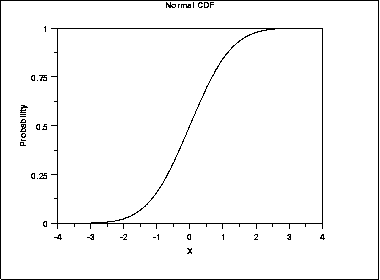A cumulative probability refers to the probability that the value of a random variable falls within a specified range. Frequently, cumulative probabilities refer to the probability that a random variable is less than or equal to a specified value.
It is convenient to have one object that describes a distribution in the same way, regardless of the type of variable, and which returns probabilities directly. This object is called the cumulative distribution function (cdf)
Consider a coin flip experiment. If we flip a coin two times, we might ask: What is the probability that the coin flips would result in one or fewer heads? The answer would be a cumulative probability. It would be the probability that the coin flip results in zero heads plus the probability that the coin flip results in one head. Thus, the cumulative probability would equal:
P(X < 1) = P(X = 0) + P(X = 1) = 0.25 + 0.50 = 0.75
| Number of heads | Probability | Cumulative Probability |
| 0 | 0.25 | 0.25 |
| 1 | 0.50 | 0.75 |
| 2 | 0.25 | 1.00 |
The Cumulative distribution is used to define custom continuous distributions. You define the distribution by specifying [cumulative probability, value] pairs. A given pair (defined by a Prob. Level and a Value) implies that the cumulative probability of the Value is equal to the specified Prob. Level.
The following is the plot of the normal cumulative distribution function.

The horizontal axis is the allowable domain for the given probability function. Since the vertical axis is a probability, it must fall between zero and one. It increases from zero to one as we go from left to right on the horizontal axis.
A few properties of Cumulative Probability
- A cdf is defined for all values of x, regardless if x is a possible value of the RV.
- A cdf is a non-decreasing function.
- A cdf approaches 0 as the input approaches −∞.
- A cdf approaches 1 as the input approaches ∞.
- The cdf of a discrete random variable is a step function.
- The steps occur at the possible values of the random variable.
- The height of a particular step corresponds to the probability of that value.
- The cdf of a continuous random variable is a continuous function.
- The cdf of a continuous random variable is obtained by integrating the pdf, so
- The pdf of a continuous random variable is obtained by differentiating the cdf F′x = fx if X is continuous
One advantage to using cdfs is that they are defined the same way for both continuous and discrete random variables. So results stated in terms of cdfs apply for both discrete and continuous random variables. This is a little more convenient than having two versions of every definition/result/proof: a statement for discrete RVs in terms of pmfs and a separate statement for continuous RVs in terms of pdfs. .
- Log in to post comments